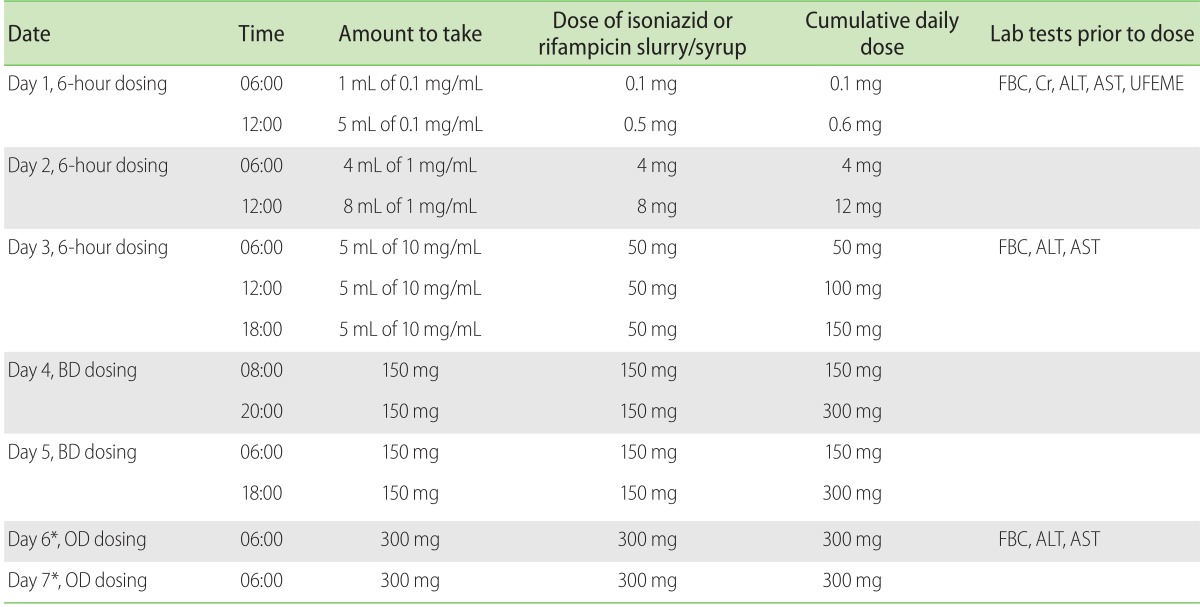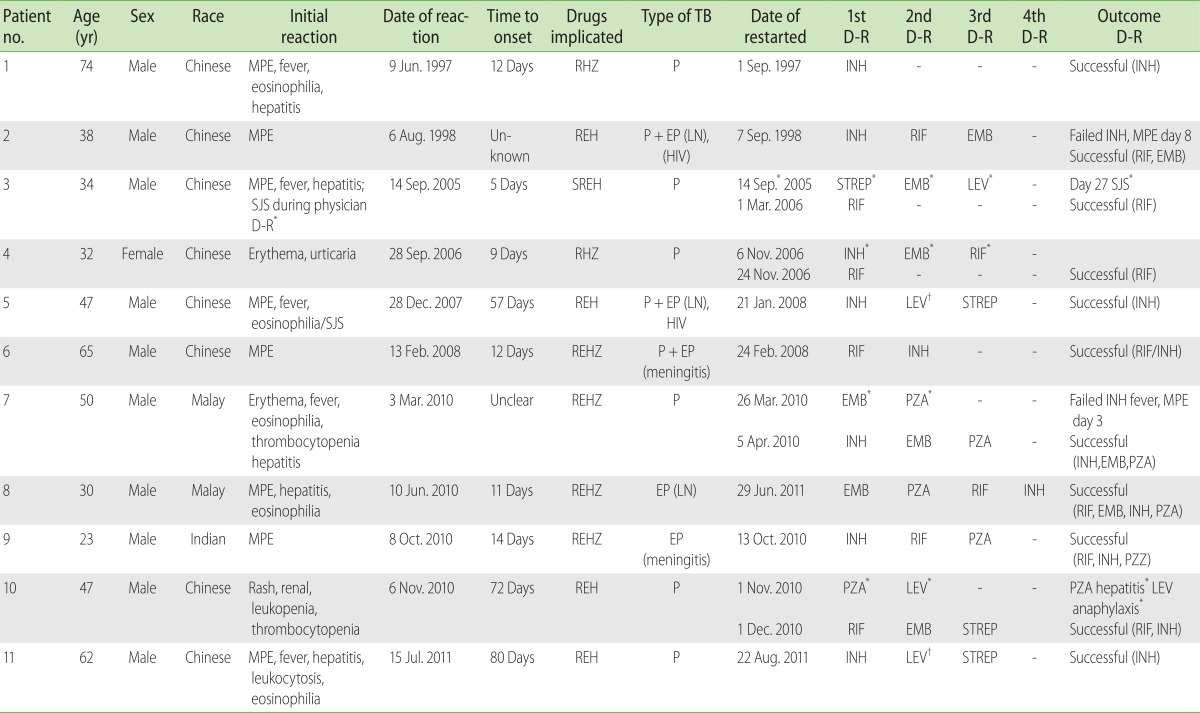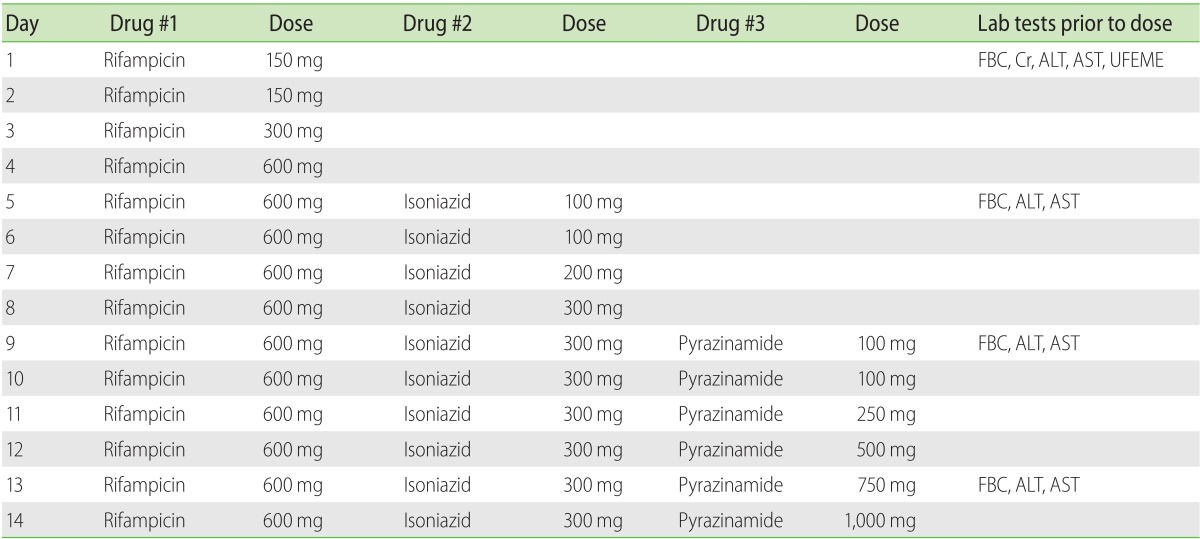1. World Health Organization. Global tuberculosis control: epidemiology, strategy, financing. WHO Report 2009. WHO/HTM/TB/2009.411. Geneva: World Health Organization;2009.
2. Cutter J, Wang YT. Tuberculosis: an under-appreciated disease. Ann Acad Med Singapore. 2010; 39:261–262. PMID:
20372765.
3. Chee CB, Wang YT. TB control in Singapore: where do we go from here? Singapore Med J. 2012; 53:236–238. PMID:
22511043.
4. Chee CB, Hsu LY, Sng LH, Leo YS, Cutter J, Wang YT. MDR TB transmission, Singapore. Emerg Infect Dis. 2013; 19:1151–1152. PMID:
23763791.

5. Forget EJ, Menzies D. Adverse reactions to first-line antituberculosis drugs. Expert Opin Drug Saf. 2006; 5:231–249. PMID:
16503745.

6. Lehloenya RJ, Dheda K. Cutaneous adverse drug reactions to anti-tuberculosis drugs: state of the art and into the future. Expert Rev Anti Infect Ther. 2012; 10:475–486. PMID:
22512756.

7. Lee AY, Jung SY. Two patients with isoniazid-induced photosensitive lichenoid eruptions confirmed by photopatch test. Photodermatol Photoimmunol Photomed. 1998; 14:77–78. PMID:
9638730.

8. Leenutaphong V, Sivayathorn A, Suthipinittharm P, Sunthonpalin P. Stevens-Johnson syndrome and toxic epidermal necrolysis in Thailand. Int J Dermatol. 1993; 32:428–431. PMID:
7686537.

9. Kim SH, Kim SH, Yoon HJ, Shin DH, Park SS, Kim YS, Park JS, Jee YK. NAT2, CYP2C9, CYP2C19, and CYP2E1 genetic polymorphisms in anti-TB drug-induced maculopapular eruption. Eur J Clin Pharmacol. 2011; 67:121–127. PMID:
20941486.

10. An HR, Wu XQ, Wang ZY, Zhang JX, Liang Y. NAT2 and CYP2E1 polymorphisms associated with antituberculosis drug-induced hepatotoxicity in Chinese patients. Clin Exp Pharmacol Physiol. 2012; 39:535–543. PMID:
22506592.

11. Kim SH, Lee SK, Kim SH, Park HW, Chang YS, Lee KW, Jee YK. Antituberculosis drug-induced hypersensitivity syndrome and its association with human leukocyte antigen. Tuberculosis (Edinb). 2013; 93:270–274. PMID:
23153709.

12. Chiriac AM, Demoly P. Multiple drug hypersensitivity syndrome. Curr Opin Allergy Clin Immunol. 2013; 13:323–329. PMID:
23799329.

13. Lochmatter P, Zawodniak A, Pichler WJ. In vitro tests in drug hypersensitivity diagnosis. Immunol Allergy Clin North Am. 2009; 29:537–554. PMID:
19563996.

14. Pichler WJ, Tilch J. The lymphocyte transformation test in the diagnosis of drug hypersensitivity. Allergy. 2004; 59:809–820. PMID:
15230812.

15. Schreiber J, Zissel G, Greinert U, Schlaak M, Muller-Quernheim J. Lymphocyte transformation test for the evaluation of adverse effects of antituberculous drugs. Eur J Med Res. 1999; 4:67–71. PMID:
10066642.
16. Yano S, Kobayashi K, Kato K, Tatsukawa T, Shishido S. The usefulness of lymphocyte stimulation test (LST) in side effects of antituberculosis drugs. Kekkaku. 2004; 79:7–10. PMID:
14969082.
17. Suzuki Y, Miwa S, Shirai M, Ohba H, Murakami M, Fujita K, Suda T, Nakamura H, Hayakawa H, Chida K. Drug lymphocyte stimulation test in the diagnosis of adverse reactions to antituberculosis drugs. Chest. 2008; 134:1027–1032. PMID:
18583516.

18. Barbaud A. Skin testing in delayed reactions to drugs. Immunol Allergy Clin North Am. 2009; 29:517–535. PMID:
19563995.

19. Barbaud A, Goncalo M, Bruynzeel D, Bircher A. European Society of Contact Dermatitis. Guidelines for performing skin tests with drugs in the investigation of cutaneous adverse drug reactions. Contact Dermatitis. 2001; 45:321–328. PMID:
11846746.
20. Bakkum RS, Waard-Van Der Spek FB, Thio HB. Delayed-type hypersensitivity reaction to ethambutol and isoniazid. Contact Dermatitis. 2002; 46:359. PMID:
12190628.

21. Ozkaya E. Eczematous-type multiple drug allergy from isoniazid and ethambutol with positive patch test results. Cutis. 2013; 92:121–124. PMID:
24153138.
22. Aberer W, Bircher A, Romano A, Blanca M, Campi P, Fernandez J, Brockow K, Pichler WJ, Demoly P. European Network for Drug Allergy (ENDA). EAACI interest group on drug hypersensitivity. Drug provocation testing in the diagnosis of drug hypersensitivity reactions: general considerations. Allergy. 2003; 58:854–863. PMID:
12911412.

23. Cernadas JR, Brockow K, Romano A, Aberer W, Torres MJ, Bircher A, Campi P, Sanz ML, Castells M, Demoly P, Pichler WJ. European Network of Drug Allergy and the EAACI interest group on drug hypersensitivity. General considerations on rapid desensitization for drug hypersensitivity: a consensus statement. Allergy. 2010; 65:1357–1366. PMID:
20716314.
24. Scherer K, Brockow K, Aberer W, Gooi JH, Demoly P, Romano A, Schnyder B, Whitaker P, Cernadas JS, Bircher AJ. ENDA, the European Network on Drug Allergy and the EAACI Drug Allergy Interest Group. Desensitization in delayed drug hypersensitivity reactions: an EAACI position paper of the Drug Allergy Interest Group. Allergy. 2013; 68:844–852. PMID:
23745779.
25. Chee CB, Lim LK, KhinMar KW, Han KY, Gan SH, Cutter J, Ooi PL, Wang YT. Surveillance of tuberculosis treatment outcomes of Singapore citizens and permanent residents, 2002-2011. Int J Tuberc Lung Dis. 2014; 18:141–146. PMID:
24429304.

26. Kobashi Y, Okimoto N, Matsushima T, Abe T, Nishimura K, Shishido S, Kawahara S, Shigeto E, Takeyama H, Kuraoka T. Desensitization therapy for allergic reactions of antituberculous drugs: evaluation of desensitization therapy according to the guideline of the Japanese Society for Tuberculosis. Kekkaku. 2000; 75:699–704. PMID:
11201137.
27. Holland CL, Malasky C, Ogunkoya A, Bielory L. Rapid oral desensitization to isoniazid and rifampin. Chest. 1990; 98:1518–1519. PMID:
2245698.

28. Kim JH, Kim HB, Kim BS, Hong SJ. Rapid oral desensitization to isoniazid, rifampin, and ethambutol. Allergy. 2003; 58:540–541. PMID:
12757467.

29. Rodrigues Carvalho S, Silva I, Leiria-Pinto P, Rosado-Pinto J. Rapid oral tolerance induction to isoniazid and pyrazinamide and controlled administration of ethambutol: clinical case. Allergol Immunopathol (Madr). 2009; 37:336–338. PMID:
19875222.

30. Nishizawa Y, Yasui M, Yamamori C, Tagami A, Fujimura M, Nakao S. A case of successful desensitization therapy for isoniazid-induced neumonitis. Nihon Kokyuki Gakkai Zasshi. 2004; 42:649–654. PMID:
15357268.
31. Ikegame S, Wakamatsu K, Fujita M, Nakanishi Y, Kajiki A. A case of isoniazid-induced liver injury diagnosed by use of the DLST, and successful reintroduction of isoniazid for pleural tuberculosis. J Infect Chemother. 2011; 17:530–533. PMID:
21188445.

32. Kamiya H, Toyota E, Kobayashi N, Kudo K. A case of pulmonary tuberculosis complicated with an orthotopic liver transplantation. Kekkaku. 2006; 81:351–355. PMID:
16715944.
33. Dutau H, Saadjian M, Bonneau V, Charpin D. Unsuccessful rapid intravenous desensitization to rifampicin. Allergy. 2000; 55:778–779. PMID:
10955706.

34. Matz J, Borish LC, Routes JM, Rosenwasser LJ. Oral desensitization to rifampin and ethambutol in mycobacterial disease. Am J Respir Crit Care Med. 1994; 149(3 Pt 1):815–817. PMID:
8118654.

35. Buergin S, Scherer K, Hausermann P, Bircher AJ. Immediate hypersensitivity to rifampicin in 3 patients: diagnostic procedures and induction of clinical tolerance. Int Arch Allergy Immunol. 2006; 140:20–26. PMID:
16514245.

36. Bavbek S, Yılmaz I, Aydın O, Ozdemir SK. Pyrazinamide-induced anaphylaxis: diagnosed by skin test and successful desensitization. Int Arch Allergy Immunol. 2012; 157:209–212. PMID:
21986254.

37. Shim TS, Jo KW. Medical treatment of pulmonary multidrug-resistant tuberculosis. Infect Chemother. 2013; 45:367–374. PMID:
24475350.

38. Kura MM, Hira SK. Reintroducing antituberculosis therapy after Stevens-Johnson syndrome in humanimmunodeficiency virus-infected patients with tuberculosis: role of desensitization. Int J Dermatol. 2001; 40:481–484. PMID:
11679013.
39. Joint Tuberculosis Committee of the British Thoracic Society. Chemotherapy and management of tuberculosis in the United Kingdom: recommendations 1998. Thorax. 1998; 53:536–548. PMID:
9797751.
40. Lehloenya RJ, Todd G, Badri M, Dheda K. Outcomes of reintroducing anti-tuberculosis drugs following cutaneous adverse drug reactions. Int J Tuberc Lung Dis. 2011; 15:1649–1657. PMID:
22118173.

41. Cernadas JR, Santos N, Pinto C, Mota PC, Castells M. Hypersensitivity reaction and tolerance induction to ethambutol. Case Rep Med. 2013; 2013:208797. PMID:
23983702.







 PDF
PDF ePub
ePub Citation
Citation Print
Print



 XML Download
XML Download